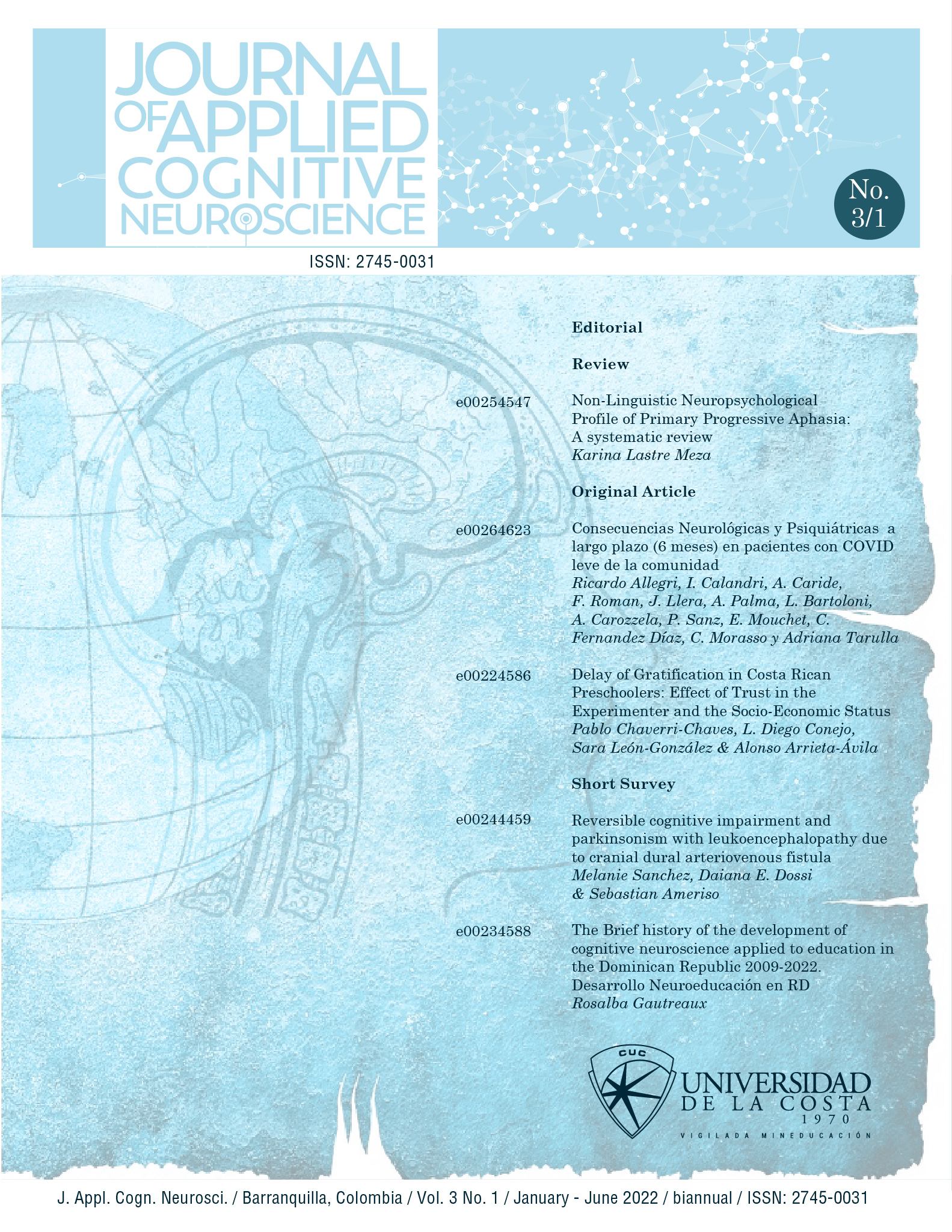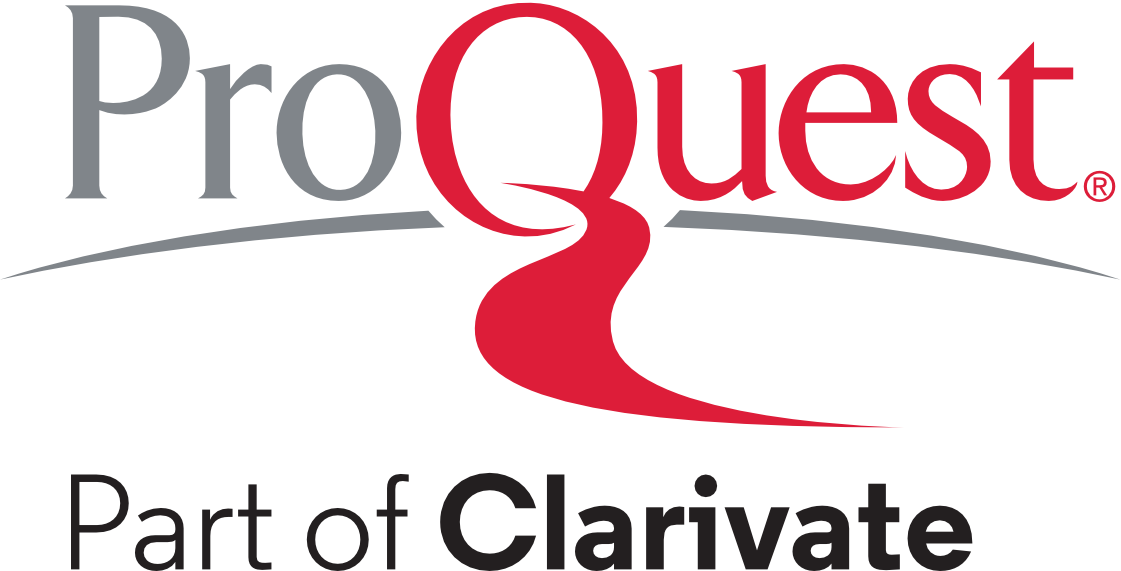Consecuencias Neurológicas y Psiquiátricas a largo plazo (6 meses) en pacientes con COVID leve de la comunidad.
Long-term (6 months) neurological and psychiatric consequences in mild COVID community patients
DOI:
https://doi.org/10.17981/JACN.3.1.2022.03Palabras clave:
post-COVID, síntomas neurológicos, psiquiátricos, long-COVID, COVID leve.Resumen
Las complicaciones neurológicas a largo plazo de la infección por coronavirus han sido descriptas en los pacientes hospitalizados en el episodio agudo. De ellos el 63% presentaron fatiga y debilidad muscular, el 26% trastornos del sueño; 24% trastornos en la marcha y 23% ansiedad y depresión. A mayor severidad del episodio agudo mayor probabilidad de sintomatología neurológica a largo plazo. El objetivo de este trabajo fue estudiar la prevalencia de síntomas neurológicos y psiquiátricos a los 6 meses en una cohorte de pacientes adultos, principalmente ambulatorios. Fueron evaluados mediante una entrevista telefónica 96 sujetos con una media de edad de 48 años, 54% mujeres, y el 86 % ambulatorios leves. De ellos a los 6 meses el 32% de la población presentaba aun síntomas neurológicos o psiquiátricos. Ansiedad (31%), fatiga (26%), niebla mental (24%), insomnio (22%), depresión (21%), y cefalea (19%) entre otros. Conclusiones: en el presente trabajo con sujetos que sufrieron COVID leve los síntomas neurológicos y psiquiátricos post COVID continuaron prominentes como lo reportado en otros trabajos en las formas agudas más graves.
Descargas
Citas
Allegri, R. F.; Roman, F. & Barceló, E. (2020). Towards the Journal of Applied Cognitive Neuroscience. Journal of Applied Cognitive Neuroscience, 1(1), 1–8.
https://doi.org/10.17981/JACN.1.1.2020.04
Beghi, E.; Giussani, G.; Westenberg, E.; Allegri, R.; Garcia-Azorin, D.; Guekht, A.; Frontera, J.; Kivipelto, M.; Mangialasche, F.; Mukaetova-Ladinska, E. B.; Prasad, K.; Chowdhary, N. & Winkler, A. S. (2022). Acute and post-acute neurological manifestations of COVID-19: present findings, critical appraisal, and future directions. Journal of Neurology, 269(5), 2265–2274.
https://doi.org/10.1007/s00415-021-10848-4
CABA. Ministerio de Salud. (s.f.). Actualización de los casos de coronavirus en la Ciudad [Base de datos].
Calandri, I.; Hawkes, M. A.; Marrodan, M.; Ameriso, S. F.; Correale, R. F. & Allegri, R. F. (2020). The impact of an early strict nationwide lockdown on the pattern of consultation for neurological diseases. Journal of the Neurological Sciences, 418, 1–22.
https://doi.org/10.1016/j.jns.2020.117084
Calandri, I. L.; Hawkes, M. A.; Marrodan, M.; Ameriso, S. F.; Correale, J. & Allegri, R. F. (2021). Changes in the Care of Neurological Diseases During the First Wave of the COVID-19 Pandemic: A Single Private Center Study in Argentina. Frontiers Neurology, 12, 1–8.
https://doi.org/10.3389/fneur.2021.613838
CDC. (2022, Dec. 16). Long COVID or Post-COVID Conditions.
https://www.cdc.gov/coronavirus/2019-ncov/long-term-effects/index.html
Cohen, G.; Russo, M. J.; Campos, J. A. & Allegri, R. F. (2020a). COVID-19 Epidemic in Argentina: Worsening of Behavioral Symptoms in Elderly Subjects with Dementia Living in the Community. Frontiers Psychiatry, 11, 1–10.
https://doi.org/10.3389/fpsyt.2020.00866
Crivelli, L., Calandri, I., Corvalán, N., Carello, M. A., Keller, G., Martínez, C., Arruabarrena, M. & Allegri, R. (2022a). Cognitive consequences of COVID-19: results of a cohort study from South America. Arquivos Neuropsiquiatria, 80(3), 240–247.
https://doi.org/10.1590/0004-282x-anp-2021-0320
Crivelli, L., Palmer, K., Calandri, I., Guekht, A., Beghi, E., Carroll, W., Frontera, J., García-Azorín, D., Westenberg, E., Winkler, A. S., Mangialasche, F., Allegri, R. F. & Kivipelto, M. (2022b). Changes in cognitive functioning after COVID-19: A systematic review and meta-analysis. Alzheimers Dement, 18(5), 1047–1066.
https://doi.org/10.1002/alz.12644
Cohen, G.; Russo, M. J.; Campos, J. A. & Allegri, R. F. (2020b). Living with dementia: increased level of caregiver stress in times of COVID-19. International Psychogeriatrics, 30, 1–5.
https://doi.org/10.1017/S1041610220001593
Dos Santos, L. V.; Calandri, I.; Slachevsky, A.; Graviotto, H. G.; Santos, M. C.; Bezerra, C.; Rossettih, A.; Generoso, A. B.; Carmona, K.; Cardoso, L. A.; Sorbara, M.; Pinto, A.; Guajardo, T.; Olavarria, L.; Thumalac, D.; Crivelli, L.; Vivas, L.; Allegri, R. F.; Tonidan, M.; Serrano, C.; Miranda-Castillo, C. & Caramelli, P. (2021). Impact of Social Isolation on People with Dementia and Their Family Caregivers. Journal of Alzheimer’s Disease, 81(2), 607–617.
https://doi.org/10.3233/jad-201580
Helms, J.; Kremer, S.; Merdji, H.; Clere-Jehl, R.; Schenck, M.; Kummerlen, C.; Collange, O.; Boulay, C.; Fafi-Kremer, S.; Ohana, M.; Anheim, M. & Meziani, F. (2020). Neurologic features in severe SARS-CoV-2 infection. The New England Journal of Medicine, 382(23), 2268–2270.
https://doi.org/10.1056/NEJMc2008597
Henry, J.; Smeyne, R. J.; Jang, H.; Miller, B. & Okun, M. S. (2010). Parkinsonism and neurological manifestationsof influenza throughout the 20th and21st centuries. Parkinsonism & Related Disorders, 16(9), 566–571.
https://doi.org/10.1016/j.parkreldis.2010.06.012
Huang, C.; Huang, L.; Wang, Y.; Li, X.; Ren, L.; Gu, X.; Kang, L.; Guo, L.; Liu, M.; Zhou, X.; Luo, J.; Huang, Z.; Tu, S.; Zhao, Y.; Chen, L.; Xu, D.; Li, Y.; Li, C.; Peng, L.; Li, Y.; Xie, W.; Cui, D.; Shang, L.; Fan, G.; Xu, J.; Wang.; Wang.; Zhong.; Wang.; Wang, J.; Zhang, D. & Cao, B. (2021). 6-month consequences of COVID-19 in patients discharged from hospital: a cohort study. Lancet, 397(10270), 220–232.
https://doi.org/10.1016/S0140-6736(20)32656-8
Kim, J. E.; Heo, J. H.; Kim, H. O.; Song, S. H.; Park, S. S.; Park, T. H.; Ahn, J. Y.; Kim, M. K. & Choi, J. P. (2017). Neurological complications during treatment of Middle East respiratorysyndrome. Journal of Clinical Neurology, 13(3), 227–233.
https://doi.org/10.3988/jcn.2017.13.3.227
Lee, N.; Hui, D.; Wu, A.; Chan, P.; Cameron, P.; Gavin, M.; Ahuja, A.; Yung, M. Y.; Leung, C. B.; To, K. F.; Lui, S. F.; Szeto, C. C.; Chung, S. & Sung, J. J. (2003). A major outbreak of severe acute respiratory syndrome in Hong Kong. The New England Journal of Medicine, 348, 1986–1994.
https://doi.org/10.1056/nejmoa030685
Li, Y. C.; Bai, W. Z. & Hashikawa, T. (2020a). The neuroinvasive potential of SARS-CoV2 may be at least partially responsible for the respiratory failure of COVID-19 patients. Journal of medical virology, 92(6), 552–555.
https://doi.org/10.1002/jmv.25728
Li, Y.; Li, M.; Wang, M.; Zhou, Y.; Chang, J.; Xian, Y.; Wang, D.; Mao, L.; Jin, H. & Hu, B. (2020b). Acute cerebrovascular disease following COVID-19: A single center, retrospective, observational study. Stroke and Vascular Neurology, 5(30), 279–284.
https://doi.org/10.1136/svn-2020-000431
Matias-Guiu, J. A.; Sung, S. F.; Hsieh, C. Y.; Nezu, T.; Porta-Etessam, J. & Allegri, R. F. (2021). Editorial: Consequences of the COVID-19 Pandemic on Care for Neurological Conditions. Frontiers Neurology, 12, 1–3.
https://doi.org/10.3389/fneur.2021.788912
Misra, S.; Kolappa, K.; Prasad, M.; Radhakrishnan, D.; Thakur, K.; Solomon, T.; Michael, B. D.; Winkler, A. S.; Beghi, E.; Guekht, A.; Pardo, C. A.; Wood, G. K.; Chou, S. H.-Y.; Fink, E. L.; Schmutzhard, E.; Kheradmand, A.; Hoo, F. K.; Kumar, A.; Das, A.; Srivastava, A. K.; Agarwal, A.; Dua, T. & Prasad, K. (2021). Frequency of neurological manifestations in COVID-19: a systematic review and meta-analysis. Neurology, 97(23), e2269–e2281.
https://doi.org/10.1212/wnl.0000000000012930
Nersesjan, V.; Amiri, M.; Lebech, A.; Roed, C.; Mens, H.; Russell, L.; Fonsmark, L.; Berntsen, M.; Sigurdsson, S. T.; Carlsen, J.; Langkilde, A. R.; Martens, P.; Lund, E. L.; Hansen, K.; Jespersen, B.; Folke, M. N.; Meden, P.; Hejl, A.; Wamberg, C.; Benros, M. E. & Kondziella, D. (2021). Central and peripheral nervous system complications of COVID-19: a prospective tertiary center cohort with 3-month follow-up. Journal of Neurology, 268(9), 3086–3104.
https://doi.org/10.1007/s00415-020-10380-x
Premraj, L., Kannapadi, N. V., Briggs, J., Seal, S. M., Battaglini, D., Fanning, J., Suen, J., Robba, C., Fraser, J., Cho, S. M. (2022). Mid and long-term neurological and neuropsychiatric manifestations of post-COVID-19 syndrome: A meta-analysis. Journal of the Neurologycal Sciences, 434, 1–8.
https://doi.org/10.1016/j.jns.2022.120162
República Argentina. Ministerio de Salud. (s.f.). Sala de Situación [Base de datos].
https://www.argentina.gob.ar/coronavirus/informes-diarios/sala-de-situacion
Saad, M.; Omrani, A. S.; Baig, K.; Bahloul, A.; Elzein, F.; Matin, M. A.; Selim, M. A. A.; Mutairi, M. A.; Nakhli, D. A.; Aidaroos, A. Y. A.; Sherbeeni, N. A.; Al-Khashan, H. I.; Memish, Z. A. & Albarrak, A. M. (2014). Clinical aspects and outcomes of 70 patients with Middle East respiratorysyndrome coronavirus infection: asingle-center experience in Saudi Arabia. International Journal of Infectious Diseases, 29, 301–306.
https://doi.org/10.1016/j.ijid.2014.09.003
Stefano, G. B.; Ptacek, R.; Ptackova, A.; Martin, A. & Kream, R. M. (2021). Selective Neuronal Mitochondrial Targeting in SARS-CoV-2 Infection Affects Cognitive Processes to Induce ‘Brain Fog’ and Results in Behavioral Changes that Favor Viral Survival. Med Sci Monit, 27, 1–4.
https://doi.org/10.12659/MSM.930886
Taquet, M.; Geddes, J.; Husain, M.; Luciano, S. & Harrison, P. J. (2021). 6-month neurological and psychiatric outcomes in 236379 survivors of COVID-19: a retrospective cohort study using electronic health records. The Lancet Psychiatry, 8, 416–427.
https://doi.org/10.1016/S2215-0366(21)00084-5
Tsai, L.-K.; Hsieh, S.-T. & Chang, Y.-C. (2005). Neurological manifestationsin severe acute respiratory syndrome. Acta Neurologica Taiwanica, 14(3), 113–119.
http://www.ant-tnsjournal.com/Mag_Files/14-3/14-3_p113.pdf
Varga, Z.; Flammer, A. J.; Steiger, P.; Haberecker, M.; Andermatt, R.; Zinkernagel, A. S.; Mehra, M. R.; Schuepbach, R. A.; Ruschitzka & F., Moch, H. (2020). Endothelial cell infection and endotheliitis in COVID-19. Lancet, 395(10234), 1417–1418.
https://doi.org/10.1016/S0140-6736(20)30937-5
Xu, J., Zhong, S.; Liu, J.; Li, L.; Li, Y.; Wu, X.; Zhijie, L.; Deng, P.; Zhang, J.; Zhong, N.; Ding, Y. & Jiang, Y. (2005). Detection of severe acute respiratory syndrome coronavirus in the brain: potential role of the chemokine Mig in pathogenesis. Clinical Infectious Diseases, 41(8), 1089–1096.
https://doi.org/10.1086/444461
WHO. (s.f.). Who Coronavirus (COVID-19) Dashboard [Database].
WHO. (2021a). Scientific brief: Neurology and COVID-19. Scientific brief 29 September 2021. WHO.
https://www.who.int/publications/i/item/WHO-2019-nCoV-Sci-Brief-Neurology-2021.1
WHO. (2021b). A clinical case definition of post COVID 19 conditions by a Delphi consensus, 6 October 2021. WHO.
https://apps.who.int/iris/handle/10665/345824
WHO. (2021c). Living guidance for Clinical management of COVID-19. Living guidance 23 november 2021. WHO.
https://apps.who.int/iris/bitstream/handle/10665/349321/WHO-2019-nCoV-clinical-2021.2-eng.pdf
WHO. (2022). Strategy for bulding resilent health systems and post-COVID Pandemic Recovery to sustain and protect health gains. PAHO.
Descargas
Publicado
Cómo citar
Número
Sección
Licencia
Derechos de autor 2022 Journal of Applied Cognitive Neuroscience

Esta obra está bajo una licencia internacional Creative Commons Atribución-NoComercial-SinDerivadas 4.0.
Usted es libre de:
1. Compartir - copiar y redistribuir el material en cualquier medio o formato.
2. El licenciante no puede revocar estas libertades siempre que usted respete los términos de la licencia.
Bajo los siguientes términos:
1. Atribución - Usted debe dar el crédito apropiado, proporcionar un enlace a la licencia, e indicar si se hicieron cambios. Puede hacerlo de cualquier manera razonable, pero no de forma que sugiera que el licenciante le respalda a usted o a su uso.
2. NoComercial - No puede utilizar el material con fines comerciales.
3. NoDerivados - Si remezcla, transforma o construye sobre el material, no puede distribuir el material modificado.
4. Sin restricciones adicionales - Usted no puede aplicar términos legales o medidas tecnológicas que restrinjan legalmente a otros de hacer cualquier cosa que la licencia permita.


 English
English
 Español (España)
Español (España)










